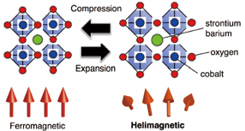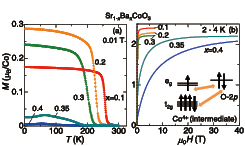Ferromagnetic-to-Helimagnetic Transition in Cubic Perovskites Sr1-xBaxCoO3
H. Sakai, M. Tokunaga, and S. Ishiwata
Helimagnets have recently attracted great interest in terms of fundamental physics and (spin)electronic application, owing to their novel functions that simple ferromagnets have never attained. Typical examples include spin-spiral-driven ferroelectricity in perovskite-type manganites and current-driven motion of magnetic skyrmions in chiral magnets. However, since the helimagnetic order originates from several competing magnetic interactions, its emergence is highly limited by strong constraints on the lattice and spin systems.

Fig. 1. Schematic illustration of the helimagnetic-ferromagnetic transition driven by the lattice expansion/compression in the cubic perovskite Sr1-xBaxCoO3.

Fig. 2. (a) Temperature (T) profiles of magnetisation (M) at 0.01 T for Sr1−xBaxCoO3 (0.1 ≤ x ≤ 0.4) single crystals. (b) Field dependence of M at the lowest temperature (2-4 K) for x=0.1-0.4. The profiles up to ∼40 T were measured with a pulse magnet. Inset shows schematic diagram of intermediate spin configuration of Co4+. L denotes an oxygen ligand hole.
Here we report the emergence of helimagnetism out of room-temperature ferromagnetism in simple cubic perovskites Sr1-xBaxCoO3 by the negative chemical pressure (Fig. 1). By utilising a high-pressure technique, we have successfully grown a series of single crystals with systematical chemical compositions. With the isotropic lattice expansion by Ba substitution, room-temperature ferromagnetism for SrCoO3 is markedly suppressed, leading to incommensurate helimagnetism, while the simple cubic structure remains intact. High-resolution neutron diffraction the Ba-substituted compounds has revealed the helimagnetic correlation that evolves towards low temperatures in competition with ferromagnetic one [1].
Figure 2(a) shows the temperature dependence of the magnetisation M at 0.01 T for Sr1−xBaxCoO3, measured upon heating after a field cooling process. With increasing x from 0.1 to 0.35, the ferromagnetic Curie temperature TC decreases systematically from 256 K to 176 K. For x = 0.35, the increase in M below TC is largely reduced, and instead a clear drop in M upon cooling manifests itself at TM (∼43 K). For x = 0.4, the ferromagnetic transition disappears and the drop in M is more conspicuous. This corresponds to the onset of the helimagnetic correlations as revealed by the neutron diffraction experiments. To check the spin state of Co4+ ions upon Ba substitution, we have also measured the field profile of M at the lowest temperature (2−4 K) (Fig. 2(b)). For x = 0.1−0.3 with the ferromagnetic ground state, the M value is saturated above ∼2 T, whereas the saturation field is substantially enhanced with increasing x to 0.35, where the helimagnetic instability sets in. The value of M barely saturates at above ∼30 T for x = 0.35. From these data, we have found that the saturation moment is almost constant (∼2.2−2.5μB/Co) with x up to 0.35 in spite of a significant decrease in TC. The spin state thus appears to remain in a nearly intermediate, i.e., S = 3/2, configuration, which is likely to be strongly hybridised with the ligand hole states (see the inset to Fig. 2(b)).
Our results indicate that the subtle balance among the magnetic interactions can be controlled by the lattice size, i.e., bandwidth, which reflects the strong p-d hybridization inherent in the unusually high-valence Co4+ state. The discovery of the helimagnetic order by expanding the simple cubic lattice provides a foundation for investigating the properties of many other crystalline materials.
References
- [1] H. Sakai, S. Yokoyama, A. Kuwabara, J. S. White, E. Canévet, H. M. Rønnow, T. Koretsune, R. Arita, A. Miyake, M. Tokunaga, Y. Tokura, and S. Ishiwata, Phys. Rev. Materials. 2, 104412 (2018).
